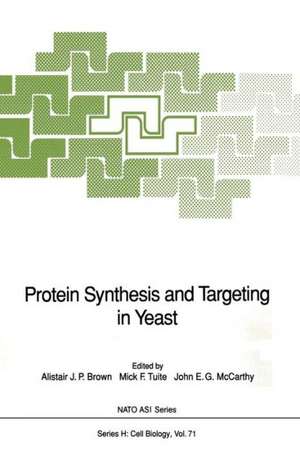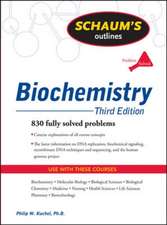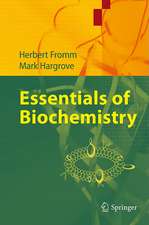Protein Synthesis and Targeting in Yeast: Nato ASI Subseries H:, cartea 71
Editat de Alistair J.P. Brown, Mick F. Tuite, John E. G. McCarthyen Limba Engleză Paperback – 14 apr 2014
Din seria Nato ASI Subseries H:
- 18%
 Preț: 953.82 lei
Preț: 953.82 lei -
 Preț: 393.13 lei
Preț: 393.13 lei - 15%
 Preț: 643.34 lei
Preț: 643.34 lei - 15%
 Preț: 643.34 lei
Preț: 643.34 lei - 15%
 Preț: 641.03 lei
Preț: 641.03 lei - 15%
 Preț: 642.83 lei
Preț: 642.83 lei - 15%
 Preț: 642.51 lei
Preț: 642.51 lei - 5%
 Preț: 712.81 lei
Preț: 712.81 lei -
 Preț: 392.97 lei
Preț: 392.97 lei - 15%
 Preț: 651.02 lei
Preț: 651.02 lei - 15%
 Preț: 640.24 lei
Preț: 640.24 lei - 18%
 Preț: 948.61 lei
Preț: 948.61 lei - 15%
 Preț: 655.92 lei
Preț: 655.92 lei - 15%
 Preț: 655.92 lei
Preț: 655.92 lei - 15%
 Preț: 653.14 lei
Preț: 653.14 lei - 15%
 Preț: 650.19 lei
Preț: 650.19 lei - 15%
 Preț: 655.13 lei
Preț: 655.13 lei - 15%
 Preț: 652.17 lei
Preț: 652.17 lei - 15%
 Preț: 675.58 lei
Preț: 675.58 lei - 18%
 Preț: 958.07 lei
Preț: 958.07 lei - 18%
 Preț: 961.41 lei
Preț: 961.41 lei - 18%
 Preț: 970.56 lei
Preț: 970.56 lei - 5%
 Preț: 1100.30 lei
Preț: 1100.30 lei - 5%
 Preț: 376.43 lei
Preț: 376.43 lei - 15%
 Preț: 650.86 lei
Preț: 650.86 lei - 15%
 Preț: 644.63 lei
Preț: 644.63 lei - 15%
 Preț: 655.60 lei
Preț: 655.60 lei - 18%
 Preț: 963.47 lei
Preț: 963.47 lei - 15%
 Preț: 648.42 lei
Preț: 648.42 lei - 5%
 Preț: 731.43 lei
Preț: 731.43 lei - 15%
 Preț: 653.14 lei
Preț: 653.14 lei - 18%
 Preț: 960.13 lei
Preț: 960.13 lei - 18%
 Preț: 968.34 lei
Preț: 968.34 lei - 18%
 Preț: 953.97 lei
Preț: 953.97 lei - 15%
 Preț: 654.95 lei
Preț: 654.95 lei - 15%
 Preț: 652.49 lei
Preț: 652.49 lei - 15%
 Preț: 650.86 lei
Preț: 650.86 lei - 5%
 Preț: 367.64 lei
Preț: 367.64 lei - 5%
 Preț: 1104.68 lei
Preț: 1104.68 lei - 18%
 Preț: 953.20 lei
Preț: 953.20 lei - 15%
 Preț: 651.99 lei
Preț: 651.99 lei - 15%
 Preț: 647.27 lei
Preț: 647.27 lei - 15%
 Preț: 653.00 lei
Preț: 653.00 lei - 15%
 Preț: 656.25 lei
Preț: 656.25 lei - 18%
 Preț: 962.35 lei
Preț: 962.35 lei - 15%
 Preț: 644.82 lei
Preț: 644.82 lei - 15%
 Preț: 666.55 lei
Preț: 666.55 lei - 15%
 Preț: 642.68 lei
Preț: 642.68 lei - 15%
 Preț: 645.96 lei
Preț: 645.96 lei - 15%
 Preț: 651.84 lei
Preț: 651.84 lei
Preț: 647.27 lei
Preț vechi: 761.49 lei
-15% Nou
Puncte Express: 971
Preț estimativ în valută:
123.85€ • 129.66$ • 102.48£
123.85€ • 129.66$ • 102.48£
Carte tipărită la comandă
Livrare economică 07-21 aprilie
Preluare comenzi: 021 569.72.76
Specificații
ISBN-13: 9783642849237
ISBN-10: 3642849237
Pagini: 414
Ilustrații: XV, 414 p. 40 illus.
Dimensiuni: 155 x 235 x 28 mm
Greutate: 0.61 kg
Ediția:Softcover reprint of the original 1st ed. 1993
Editura: Springer Berlin, Heidelberg
Colecția Springer
Seria Nato ASI Subseries H:
Locul publicării:Berlin, Heidelberg, Germany
ISBN-10: 3642849237
Pagini: 414
Ilustrații: XV, 414 p. 40 illus.
Dimensiuni: 155 x 235 x 28 mm
Greutate: 0.61 kg
Ediția:Softcover reprint of the original 1st ed. 1993
Editura: Springer Berlin, Heidelberg
Colecția Springer
Seria Nato ASI Subseries H:
Locul publicării:Berlin, Heidelberg, Germany
Public țintă
ResearchCuprins
Mrna Stability and Translation.- 1: Identification of the cis-acting sequences and trans-acting factors involved in nonsense-mediated mRNA decay.- 2: RNA14 and RNA15, two proteins regulating mRNA stability in Saccharomyces cerevisiae.- 3: Translational control in Saccharomyces cerevisiae studies in vivo and in vitro.- The Ribosome.- 4: Thoughts on the regulation of ribosome synthesis in Saccharomyces cerevisiae.- 5: Regulation of ribosomal protein synthesis in yeasts (Saccharomyces and Kluyveromyces).- 6: The evolution of ribosomal proteins and yeast.- 7: The acidic ribosomal proteins and the control of protein synthesis in yeast.- Translational Fidelity.- 8: SUP35 and SUP45 genes code for ribosome-bound proteins involved in the control of translational fidelity in yeast.- 9: Mutations affecting translational accuracy in yeast.- 10: Dosage-dependent modifiers of psi’-dependent omnipotent suppression in yeast.- 11: Aberrant mRNA decoding by the dimorphic yeast Candida albicans.- Translation Factors.- 12: Effect of initiation factor eIF-5A depletion on cell proliferation and protein synthesis.- 13: Analysis of the genes encoding eIF-4A from yeast.- 14: Uncharged tRNA and derepression of the general amino acid control: autoregulation of yeast lysyl-tRNA synthetase.- Translation in the Mitochondrion.- 15: Positive control of translation in organellar genetic systems.- 16: Translation in yeast mitochondria.- 17: Yeast mitochondrial translation: nuclear genes involved in the expression of the mitochondrial genome.- Mitochondrial Import and Sorting.- 18: Early events in protein import into mitochondria.- 19: Targeting pathways to the mitochondrial inner membrane.- 20: Intra-mitochondrial sorting of precursor proteins.- 21: Genetic characterization of the intermembrane spacesorting domains of yeast cytochrome b2.- 22: Mitochondrial import of cytochrome C.- Nuclear Transport.- 23: Using yeast to study exchange of macromolecules between the cytoplasm and the nucleus..- 24: Nucleocytoplasmic transport in ribosome biogenesis.- 25: Approaches towards a genetic analysis of the nuclear pore complex in yeast.- Targeting to the Endoplasmic Reticulum and Beyond.- 26: The SRP-dependent protein targeting pathway in Saccharomyces cerevisiae.- 27: Similarities between Scerevisiae Sec 61p and E. coli SecY suggest a common origin for protein translocases of the eukaryotic ER and the bactenal plasma membrane.- 28: ATP transport into yeast ER is a prerequisite for preprotein transfer across the ER membrane.- 29: Cross-linking signal sequences to components of yeast microsomes.- 30: The nucleotide cycle of SEC4 is important for its function in vesicular transport.- 31: Vacuolar protein sorting in yeast.- 32: Eukaryotic MDR1/P-glycoprotein homologues: unconventional secretion processes mediated by a growing family of ATP-dependent membrane translocators.- Intracellular Protein Folding.- 33: The role of protein disulfide isomerase in yeast.- 34: Novel chaperone-like pro-sequences allow secretion of recombinant human insulin-like growth factor-1 from yeast.- 35: mRNA translation and protein folding in vivo.- Protein Splicing and Degradation.- 36: Protein splicing of yeast TFP1: evidence for a new class of mobile genetic elements.- 37: Ubiquitin-dependent protein degradation.- 38: The TIF463A and TIF463B genes encode the large subunits of the yeast cap binding protein complex.











